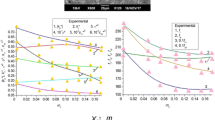Abstract
A quantitative general effective media (GEM) equation is used to describe quantitatively the resistivity of an Fe3O4-epoxy composite system over a large range of volume fractions in terms of the resistivities of each component and two percolation morphology parameters. One parameter is the critical (percolation) volume fraction, φc, and the other is an exponent,t. Preliminary models, also based on the GEM equation, are used to describe the positive temperature coefficient of resistivity (PTC) and the piezoresistivity (uniaxial pressure) of the composite when the composition is near the percolation threshold.
Similar content being viewed by others
References
A. I. Medalia,Rubber Chem. Technol. 59 (1987) 432.
R. Zallen, in “The Physics of Amorphous Solids” (Wiley, New York, 1983) Ch. 4.
R. Landauer, in “Electrical Transport and Optical Properties of Inhomogeneous Media”, American Institute of Physics Conference Proceedings no. 40, edited by J. C. Garland and D. B. Tanner (American Institute of Physics, New York, 1978) p. 2.
J. P. Straley, in “Percolation Processes and Structures”, Vol. 5, in the Annals of the Israel Physical Society, edited by G. Deutscher, R. Zallen and J. Adler (Israel Physical Society, Jerusalem, Israel, 1983) p. 353.
D. S. McLachlan,J. Phys. C 20 (1987) 865.
N. Deprez, D. S. McLachlan andI. Sigalas,Solid State Commun. 66 (1988) 869.
D. S. McLachlan andJ. P. Burger,ibid. 65 (1988) 159.
D. S. McLachlan,Jpn J. Appl. Phys. 26 Suppl. 26–3 (1987) 901.
Idem, Solid State Commun. 69 (1989) 925.
Idem, J. Phys. C 21 (1988) 1521.
P. N. Sen, C. Scala andM. H. Cohen,Geophys. 46 (1981) 781.
R. E. Meredith andC. W. Tobias, in “Advances in Electrochemistry and Electrochemical Engineering”, Vol. 2, edited by C. W. Tobias (Interscience, New York, 1962) p. 15.
S. Yoshikawa, T. Ota, R. Newnham andA. Amin,J. Amer. Ceram. Soc. 73 (1990) 263.
M. Blaszkiewicz, D. S. McLachlan andR. E. Newnham,Polym. Sci. Enqng, in press.
A. Malliaris andD. T. Turner,J. Appl. Phys. 42 (1971) 614.
R. P. Kusy,ibid. 48 (1978) 5301.
J. Gurland,Trans. Met. Soc. AIME 236 (1966) 642.
D. S. McLachlan, M. Blaszkiewicz andR. E. Newnham,J. Amer. Ceram. Soc. 73 (1990) 2187.
F. Carmona, R. Canet andP. Delhaes,J. Appl. Phys. 61 (1987) 2550.
Author information
Authors and Affiliations
Rights and permissions
About this article
Cite this article
Blaszkiewicz, M., McLachlan, D.S. & Newnham, R.E. Study of the volume fraction, temperature, and pressure dependence of the resistivity in a ceramic-polymer composite using a general effective media theory equation. J Mater Sci 26, 5899–5903 (1991). https://doi.org/10.1007/BF01130131
Received:
Accepted:
Issue Date:
DOI: https://doi.org/10.1007/BF01130131




